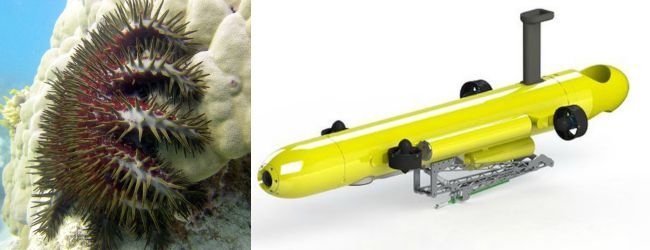
Australian scientists, Matthew Dunbabin and Feras Dayoub from Queensland University of Technology, have invented a robot designed to seek out and control the Great Barrier Reef’s crown-of-thorns starfish (COTS), which are responsible for an estimated 40 % of the reef’s total decline in coral cover. A 2012 study revealed that COTS, along with tropical cyclones, have been the two leading cause of coral cover losses over the past 27 years.
The four-foot-long missile-shaped COTSbot is designed to search the reef for up to eight hours at a time, delivering more than 200 lethal shots through its new state-of-the-art computer vision and machine learning system. The COTSbot is the first autonomous underwater vehicle to be equipped with an injection system. It’s also designed to operate exclusively within a metre of the seafloor, one of the most dynamic and challenging environments for any robot.
Dunbabin said the COTSbot was equipped with stereoscopic cameras to give it depth perception, five thrusters to maintain stability, GPS and pitch-and-roll sensors and a unique pneumatic injection arm to deliver a fatal dose of bile salts.
“Human divers are doing an incredible job of eradicating this starfish from targeted sites but there just aren’t enough divers to cover all the COTS hotspots across the Great Barrier Reef. We see the COTSbot as a first responder for ongoing eradication programs – deployed to eliminate the bulk of COTS in any area, with divers following a few days later to hit the remaining COTS. The COTSbot becomes a real force multiplier for the eradication process the more of them you deploy – imagine how much ground the programs could cover with a fleet of 10 or 100 COTSbots at their disposal, robots that can work day and night and in any weather condition,” he added.
Dunbabin said the robot wouldn’t replace trained divers, who can bring up as many as 500 starfish an hour, but it could be an important partner. “Divers can look under coral and do things that robots can’t, but where we make the most impact is to be a first responder. Let the robots do the first sweep and then rely on divers who have more dexterity to get the tricky critters,” he explained.
“Its computer system is backed by some serious computational power so COTSbot can think for itself in the water. If the robot is unsure that something is actually a COTS, it takes a photo of the object to be later verified by a human, and that human feedback is incorporated into the robot’s memory bank. We’ve now trained the robot using thousands of images of COTS collected on the reef and the system is proving itself incredibly robust at detecting the COTS,” said Dayoub, who designed the COTS-detecting software at QUT’s Science and Engineering Faculty and the Australian Centre for Robotic Vision.
The COTSbot completed its first sea trials last week in Queensland’s Moreton Bay to test its mechanical parts and navigation system. Later this month, the COTSbot will be taken out again to the Great Barrier Reef to test it on living targets. In that trial, a human will verify each COTS identification the robot makes before the robot is allowed to inject it. The COTSbot is slated to be autonomously working on the Great Barrier Reef by December this year.
This Article (Meet COTSbot, World’s First Robot That Destroys Reef-Killing Starfish) is free and open source. You have permission to republish this article under a Creative Commons license with attribution to the author and AnonHQ.com.





